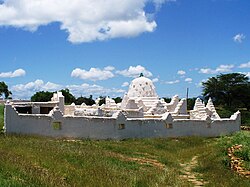SHEIKH HUSSEIN – (AN ISLAMIC PILGRIMAGE)
 Lost in the desert plains of Bale Province in Ethiopia, lies the sacred shrine of Sheikh Hussein. Its glistening white domes float in a vast sea of emerald green scrub. Through the heat haze and craggy outlines of the Bale Mountains on the distant horizon, this remote shrine and its sacred compound house the tomb of a Saint renowned for his miraculous powers.
Lost in the desert plains of Bale Province in Ethiopia, lies the sacred shrine of Sheikh Hussein. Its glistening white domes float in a vast sea of emerald green scrub. Through the heat haze and craggy outlines of the Bale Mountains on the distant horizon, this remote shrine and its sacred compound house the tomb of a Saint renowned for his miraculous powers.
Although little is known of Sheikh Hussein’s history, his shrine has become the site one of Ethiopia’s most extraordinary pilgrimages. Twice each year up to 50,000 pilgrims, most coming from Ethiopia’s remote villages, make an arduous journey to pray at the shrine of Shiekh Hussein.
Some will travel by donkey or mule, but most will walk – often barefoot – for up to 6 weeks or more to reach this sacred place. In the 700 years since the Sheikh’s death, the pilgrimage has evolved into an amalgam of Saint cult and ancient ritual.
By tradition, the departure of the pilgrims from their remote villages is governed by the waxing and waning of the moon.
Sheikh Hussein is a town in south-eastern Ethiopia. Located in the Bale Zone of the Oromia Region, it has a longitude and latitude of 7°45′N 40°42′E with an elevation of 1386 meters above sea level. The Central Statistical Agency has not published an estimate for this town’s 2005 population.
Overview
On 23 December 2007, Addis Fortune reported that SATCON Construction, an Ethiopian-owned firm, completed a four-year effort to build a 170 kilometer road through the mountainous area of the Oromia Region connecting Sheikh Hussein with the town of Micheta, located in the Darolebu woreda of the Mirab Hararghe Zone. The road was formally inaugurated 19 December.[1]
Arthur Donaldson Smith arrived at Sheikh Hussein 21 September 1894, where he spent several days, and afterwards his companion visited the tomb of Sheikh Hussein’s assistant Sheikh Mohammed.[2]
Tomb of the Saint
The town is named after what, in some Ethiopian Muslim eyes, is the most sacred place in that country: the tomb of the thirteenth century Somali saint called Sheikh Hussein, who introduced Islam to the Sidamo people living in the area at the time, and is said to have performed many miracles. A number of these miracles have been recorded in a hagiography published in Cairo in the 1920s, entitled Rabi` al-Qulub. Although this town is now within the homelands of the Oromo people, it has continued to be the destination of approximately 50,000 pilgrims from Muslim Ethiopia twice a year during the Muslim months of Hajj and Rabi’ al-Awwal.[3] The first pilgrimage is to celebrate his birth, the second his death. They traditionally carry cleft sticks known as “Oulle Sheikh Hussein”, which are too small to serve as walking sticks and are not utilized for any practical purpose. Once they arrive at the shrine, the pilgrims take their turns entering the saint’s tomb by crawling through a small doorway.[4]
The extensive religious complex dedicated to the saint includes the town and the nearby valley of Kachamsare. In the 18th century, Emir `Abd al-Shakur ibn Yusuf of Harar constructed a shrine to the Baghdadi saint `Abd al-Qadir al-Jilaninear the tomb of Sheikh Hussein, inside the shrine compound. A graveyard has also been consecrated as part of the complex.[3] Other landmarks of the complex include the pond of Dinkiro, 300 meters south of the mosque, built in dry stone masonry; associated with the pond is a spring with “miraculous” water. At the entrance of the holy area are two wild fig trees called kiltu (identified as Ficus sycomorus) in the Oromo language. Near another pond, of Imaro, there is the mosque of Sheikh Hussein’s father, both with a gubba of Harar type. Also nearby are several caves—a “cave of serpents”, a “cave of herbs”, and a “cave of honey”—and rock formations said to be petrified persons.[4]
| Sheikh Hussein | |
|---|---|
| Town | |

The shrine of Sheikh Hussein.
|
|



